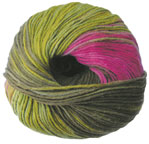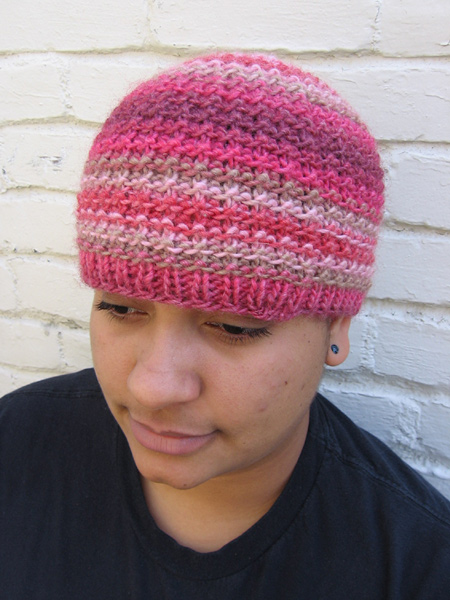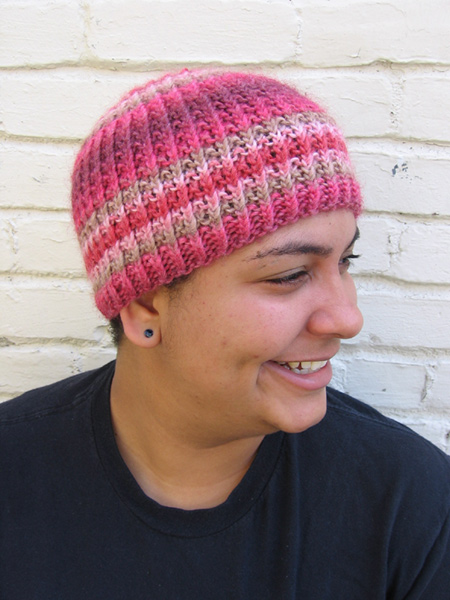I survived the Big Read. This year’s most-popular literary references included Death of a Salesman, MacBeth, Lord of the Flies, and The Great Gatsby. I was particularly struck by the number of students who cited Gatsby as an example of success, apparently having forgotten that the novel ends with his suicide. Perhaps they haven’t gotten to that chapter yet…. There was also lots of not-always-accurate discussion of the cold war and much extolling of the virtues of capitalism.
I got various bits of knitting done in my free moments: several eight-row sets of my Noro shawl, several four-row sets on my malabrigo Clementine, and a fair piece of a still-top-secret project that is to be a gift for a regular reader of this blog.
I still have two weeks of teaching left this quarter, but I’m starting to daydream about summer reading. In general, I read non-fiction: epidemiology, medical history, forensic science, early church history, history of science, biography. But every summer I go on a little mystery-novel binge and plow through the latest works by some of my favorite writers. I’ve just now been putting in book requests at my local library’s web site, so I’ll have some books waiting for me once classes end in another two weeks. Here are some of my favorite summer-reading authors:
Laurie R. King
King authors several mystery series, my favorite of which features Mary Russell, a much-younger woman who joins up with Sherlock Holmes after his retirement and later marries him. They’re both strong characters, so the negotiation of their relationship is fascinating, and the mysteries are substantial and engaging. Sadly, there’s no new Russell novel this summer, so I’m requesting The Art of Detection, which features another of her recurring characters, Kate Martinelli, a lesbian police detective working in San Francisco. In this book, Martinelli investigates the death of a Holmes aficionado, so there may be some overlap with the Russell series after all.
Elizabeth Peters
Peters is a wildly prolific writer, specializing in genre fiction. She writes a number of mystery series, as well as romance novels. I am particularly fond of the Amelia Peabody mysteries which are a sort of mystery/historical fiction/soap opera melange set in the Egyptological community during the early part of the 20th Century. Peters actually has a doctorate in Egyptology from the University of Chicago, and these novels offer a wonderful insight into the history of that field with depictions of Carter, Maspero, and other key figures. Amelia Peabody is an independently wealthy, iconoclastic, yet oddly proper, character. The first novel in the series has her meeting and becoming involved with Radcliffe Emerson, a formidable Egyptologist, who embodies the ethos of present-day archaeology (the focus on full study of a site, as opposed to treasure-hunting; a commitment to documentation of lower-class as well as royal sites and possessions). There are now eighteen books in this series. I’ve read the most recent, so as a substitute I’ve requested Amelia Peabody’s Egypt, a book introduced by Peters that depicts Egypt and the Egyptological community during the period in which the Peabody novels are set.
Kathy Reichs
Reichs’ heroine is Temperance Brennan, now also the central character of the Fox series Bones, though the literary and small-screen figures have significant differences. The Brennan of the books is, like Reichs, a forensic anthropologist who splits her time between positions in the U.S. and Canada. Brennan, as is typical of such fictional characters, spends a great deal of time riding shotgun with her detective boyfriend and engages in a great deal of hands-on bad-guy fighting, which I don’t expect bears much resemblance to Reichs’ real life, but the overlap between the fictional and real worlds means the lab scenes and details of forensic work (I am not talking about the tv series here) are specific and accurate. I listened to Reichs’ latest on CD during a cross-country drive last year, and this year will spend some time with the printed version to see what I missed on the first go-round.
Sara Paretsky
Paretsky’s heroine, V.I. Warshawski, works as a private eye in Chicago and takes on cases that involve social, as well as criminal, justice. The characters and plots in these books are rich and complex, giving readers much to think about beyond the central mystery that drives the plot. I’ve requested one older Paretsky title, Blacklist, that I somehow missed when it first came out, as well as Writing in an Age of Silence, Paretsky’s reflections on her own life as a writer and activist.
Carole Nelson Douglas
Douglas has two series, one featuring Midnight Louie, a cat, the other featuring Irene Adler, the central character of the very first Holmes mystery, “A Scandal in Bohemia.” I’d forgotten all about the Adler series until recently and was pleasantly surprised to find that the are five novels available in this series that I haven’t read yet. Holmes has figured occasionally in the Adler novels I’ve read, which adds to the fun, but it’s Irene, opera singer and independent spirit, who’s the real delight.
Marcia Muller
I’m also behind on Muller’s Sharon McCone series, which is good news for me. McCone is a San Francisco-based private eye, loosely connected to a law firm originally founded by a group of hippies hoping to change the world. The characters move between idealism and pragmatism, sometimes inspiring, sometimes disappointing, always entertaining.
And because today is Memorial Day…
Please click here and listen to today’s broadcast from National Public Radio‘s Fresh Air. Actually, today’s broadcast was a replay of a show originally recorded in March, but it’s as timely as it ever was. Host Terry Gross interviews Martha Raddatz and Richard Jadick. Raddatz is a former NPR commentator, now chief White House correspondent for ABC news, and author of a recent book, The Long Road Home, which documents 2004’s battle for Sadr City. Jardik served as a military surgeon during the battle of Fallujah and has published a memoir On Call in Hell. Regardless of our politics, regardless of our stance on the war, we all need to hear what these two people have to tell us about the current sacrifices of U.S. soldiers and their families.











